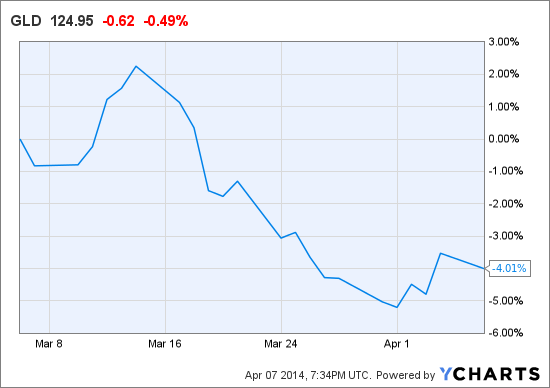iShares Barclays 20+ Year Treasury Bond (TLT 0.03%) could see renewed selling pressure after last week's nonfarm payroll employment report confirmed that the economy is in a steady recovery. According to the U.S. Bureau of Labor Statistics, nonfarm payroll employment rose by 192,000 in March, slightly beating estimates of 185,000. The unemployment rate was flat at 6.7%.
Fears of the effects of the "polar vortex" have subsided, and temperate spring weather helped bring about an undisrupted reading. This helps confirm that U.S. monetary policy is headed for higher rates, which would be a catalyst for the selling of Treasury bonds.
Although Federal Reserve Chair Janet Yellen said last week that low interest rates aimed at boosting the U.S. economy would likely be kept in place for some time, the premium tied to Treasury bonds as a safe-haven investment may be fading. The Russian invasion of Crimea sparked fears that a new Cold War could be imminent, but as tensions have eased, investor anxiety has also subsided. The change in sentiment has led funds to flow out of assets like precious metals and Treasury bonds and back into equity markets both in the U.S. and abroad.
Similarly, it can be argued that tighter monetary policy was mostly priced into market expectations during the spring of 2013. At a congressional meeting last May, former Fed Chairman Ben Bernanke said that cutting stimulus was a possibility if data warranted the move. The Fed ultimately chose not to taper stimulus until December, but the idea that stimulus was finite led 30-year bond yields to jump 100 basis points from May to September.
The concept of present value is the reason Treasury bonds sold off last May and could continue to sell off going forward. Present value is the idea that all past and future information is priced in at the present time, making everything known about the asset part of its price. When Bernanke hinted at tapering stimulus, traders acted as if he had just hiked rates. Likewise, the positive employment report allows investors to make the case that the U.S. labor market is healthy, which increases the odds that rates will rise sooner rather than later.
The recent sell-off in SPDR Gold Trust (GLD -0.25%) suggests that traces of global market stability and tighter U.S. policy are already being priced in. The precious metal was bid higher at the beginning of the year as Treasury bond prices rose and fears mounted that a war between Russia and the West could break out. As geopotical risks subsided, the metal sold off, then saw the selling intensify when Yellen hinted that benchmark rates could be elevated as early as spring of next year.
There are still a lot of questions that need to be answered about the health of the U.S. economy before stimulus is no longer needed, but the employment figure on Friday was a major stepping stone. The number exceeded expectations, and now investors can price in a healthy economy, selling off long-dated Treasury bonds along the way.





